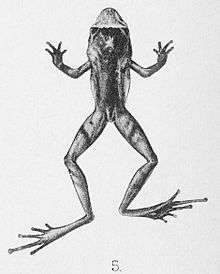Philautus kempii
Philautus kempii (not to be confused with Philautus kempiae) is a species of frog in the family Rhacophoridae.[2] It is known with certainty from its type locality,[1] Upper Rotung in Arunachal Pradesh, Northeast India, in the area also claimed by China.[2] It is also reported from Arunachal Pradesh in general as well as from extreme eastern Tibet;[2] these might represent another species. Very little is known about this species, and even its taxonomic validity remains uncertain.[1]
| Philautus kempii | |
|---|---|
 | |
| Illustration from the original species description | |
| Scientific classification | |
| Kingdom: | Animalia |
| Phylum: | Chordata |
| Class: | Amphibia |
| Order: | Anura |
| Family: | Rhacophoridae |
| Genus: | Philautus |
| Species: | P. kempii |
| Binomial name | |
| Philautus kempii (Annandale, 1912) | |
| Synonyms[2] | |
| |
Etymology and common names
The specific name kempii honours Stanley Wells Kemp, an English zoologist and anthropologist.[4] Common names Kemp's spadefoot toad, Kemp's horned toad, Kemp's bush frog, and Kemp's small treefrog have been coined for it (only the latter two accord with the current placement of this species in Rhacophoridae).[2]
Taxonomy and systematics
Philautus kempii was originally described by Nelson Annandale as Megalophrys (=Megophrys) kempii, in a genus that is now in the family Megophryidae. Later authors placed the taxon in various megophryid genera. However, in 2006 Delorme and colleagues noted that the holotype has granular belly and distinct finger and toe discs, characteristics that are not be present in Megophryidae. Instead, they concluded that Annandale's Megalophrys kempii is a rhacophorid, likely in the genus Philautus.[5] It has also been placed in other rhacophorid genera.[2]
Description
The holotype measures 15 mm (0.6 in) in snout–vent length and is at least a sub-adult. The snout is relatively long and sloping forwards, round, and truncate in profile. The tympanum is distinct. The limbs are slender. The fingers and toes bear small but distinct discs. The toes have basal webbing. Skin is smooth except for the belly. The dorsum (in preservative) is dark olive and has symmetrically arranged greyish-green marks. The snout is also greyish-green. The hind limbs have obscure cross-bands. The ventral surfaces are yellowish.[3]
Habitat and conservation
Presumably, this species inhabits tropical moist forest, but nothing definite is known regarding its habitats and biology. Threats and its presence in protected areas are unknown.[1]
References
- Sushil Dutta; Annemarie Ohler; Sohrab Uddin Sarker (2008). "Philautus kempii". IUCN Red List of Threatened Species. 2008: e.T57640A11668304. doi:10.2305/IUCN.UK.2008.RLTS.T57640A11668304.en. Retrieved 3 January 2018.
- Frost, Darrel R. (2020). "Philautus kempii (Annandale, 1912)". Amphibian Species of the World: an Online Reference. Version 6.1. American Museum of Natural History. doi:10.5531/db.vz.0001. Retrieved 23 May 2020.
- Annandale, Nelson (1912). "Zoological results of the Abor Expedition, 1911–1912. I. Batrachia". Records of the Indian Museum. 8: 7–36. doi:10.5962/bhl.part.1186.
- Beolens, Bo; Watkins, Michael & Grayson, Michael (2013). The Eponym Dictionary of Amphibians. Pelagic Publishing. p. 112. ISBN 978-1-907807-42-8.
- Delorme, M.; Dubois, A.; Grosjean, S. & Ohler, A. (2006). "Une nouvelle ergotaxinomie des Megophryidae (Amphibia, Anura)". Alytes. 24: 6–21.
